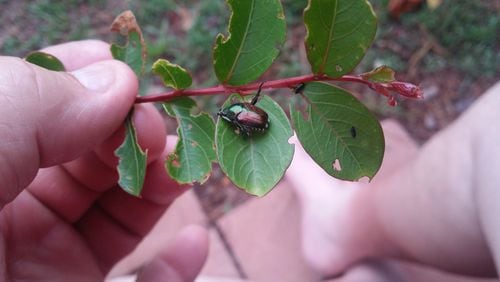Q: Why do many of our pests come from the same area of the world? We have Japanese beetles, Chinese privet, Asian ambrosia beetles, and others. Isn’t this odd? Angelitha Dyer, email
A: Pest plants, animals and diseases live where they’re most comfortable with the weather. Making a broad generalization, weather would be similar in similar geographic latitudes. Atlanta is latitude 33.74, Tokyo is 35.65, Nanjing is 32.05, Shanghai is 31.23, and Beijing is 39.91. When plants were brought from these areas into European and American gardens, the pests came with the plants and made themselves at home. To an insect or weed or disease, as long as temperatures are the same as at their former home, they’re happy. Early plant explorers dashed around the world to search areas and countries that matched the latitude in which they gardened. Pests have also gone the other way: Raccoons have run rampant in Japan; our native red-eared slider turtles have often outcompeted native Asian species for food, basking sites and nesting sites; lantana has invaded agricultural areas and dominates native plants in Asia. Diseases of squash, gourds and melons are terrible problems in Asia; here the same diseases are no problem on these plants native to the Americas.
Q: I’ve been reading that there are environmental concerns around using peat moss. Do you know of a peat-free potting mix? I don’t want my indoor plants to fail, but I’d like to reduce my environmental impact if I can. Jennifer Murray, email
A: Coir, the fibrous husk of a coconut, has been researched for decades as a substitute for peat. Coir is sustainable but it sometimes contains calcium and magnesium salts, which interfere with nutrient uptake. Peat is harvested from bogs in Canada and Nova Scotia; these bogs are slowly declining in size. I have seen Organic All-Purpose, Peat-Free Premium Potting Mix that contains coir instead of peat at big-box stores.
Q: I bought a flat of 20 tomato plants three weeks ago. I never got around to planting them. Now they are tall and floppy. Can they still be planted? Thrifty Gus, Decatur
A: Absolutely! It’s long been known that a tomato plant can make roots along the stem. There’s nothing wrong with planting the root ball on its side, burying the long stem horizontally and leaving a tuft of green leaves sticking out of the ground. The tomato plant will grow normally from that spot, and with the additional roots, you just might get more tomatoes.
Email Walter at [email protected]. Listen to his occasional garden comments on “Green and Growing with Ashley Frasca” Saturday mornings on 95.5 WSB. Visit his website, walterreeves.com, or join his Facebook page at bit.ly/georgiagardener for his latest tips.







